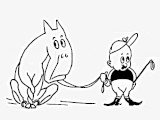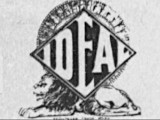

|
 | IDEAL FILM RENTING COMPANY LTD(1911-1934) |  |
||
|
The Ideal Film Renting Company was founded in 1911 by brothers Harry Moses Rowson and Simon Rowson, sons of Manchester mackintosh maker Sheftel Rosenbaum, a Russian immigrant, as a distribution company, after Harry had been to New York in 1906, and returned with film reels bought as celluloid scrap which he successfully rented out to local cinemas. TheKinematograph Weekly reported (22 February 1912): A thousand feet of celluloid film subjects for 7s. 6d. weekly, or 15s. with a daily change, or of non-flam for 15s. weekly, or 22s. 6d. daily change, is what the Ideal Film Renting Company, of 15 Gerrard Street, W., is offering exhibitors. With a stock of more than 1,000 subjects to choose from, the Company has taken Messrs. Markt and Company's old premises [...] and is making thi offer to exhibitors, who might find it to their advantage to get into communication with Mr. A. M. Kay, the manager. Started recently as the Ideal Film Company at Camden Town, business has increased so rapidly that larger premises had become absolutely necessary, hence the removal. In 1916 the company began producing films of its own to add to its distribution catalogue, and in 1919 it bought the Elstree studio from the ailing Neptune Film Company. In 1922 the company was put into liquidation, with the intention of transferring all assets and functions of the business to a new company, Ideal Films Ltd. The lessor of the premises of the company's offices at 76 Wardour St, Danish businessman Niels Nielsen, refused their request to transfer the lease to the new company, seeking to impose a new lease at a higher rent. The company took Nielsen to court, and the case hinged on the fact that the wording of the lease made it a specific and separate covenant that the lessor could not unreasonably withhold consent, as opposed to the usual caveat that the lessor's right to refuse "should not be unreasonable", which had long been held not to affect the actual right of refusal. The judge found in favour of Ideal, and the case of Ideal Film Renting Company, Limited v Nielsen became a precedent in lease law. With an emphasis on using British producers, players, scenario writers and authors Ideal Films became one of the leading British production companies, but with the British Film Slump of 1924 (a result of inflation following the post-war boom) it ceased production to concentrate on its rental business. On 30 March 1922 The Bioscope carried an item entitled "Short Feature Festival." Ideal's Novel Scheme: A new and important programme of "short features" is announced by Ideal Films in pursuance of their belief that there exists a growing popular demand for "snappier" pictures and wider variety in the cinema entertainment. This belief has recently received striking confirmation, says Mr. S. Gilbert, of Ideal, in the remarkable success of "The Tony Sarg Almanac," "A Ride on a Runaway Express," and other single-reel attractions. The Tony Sarg Almanac was a series of sihouette animation films made in the US by illustrator and puppeteer Tony Sarg, and distributed by Educational Pictures. The contract with Educational Pictures proved more valuable when in 1925 Pat Sullivan, producer of Felix the Cat, broke with his former distributor M J Winkler and signed with Educational Pictures. Sullivan had been unhappy at the way Felix had been shown in the UK: Winkler had sold the UK rights to British Pathé, who had included Felix in its magazine reel Eve's (and Everybody’s) Film Review. Because Eve's Review was weekly and the Felix films were released fortnightly, Pathé chopped the cartoons in two, showing a half each week. Despite this curtailing Felix had become hugely popular in the UK, perhaps even more than in the US, and Sullivan wanted his films shown properly in their entirety. Sullivan had tried to break with Winkler at the end of 1923, but she had threatened legal action and they had settled out of court. Sullivan and his wife had visited England in May through June 1924 when he failed to get Pathé to change their practice. When, at the end of the year, it became clear that Sullivan was still intent on leaving Winkler, Pathé made a belated attempt to placate him by issuing the last five films of the 1924 series as stand-alone releases, but it was too little too late, and Sullivan approved Educational Pictures's contract with Ideal. Sullivan and his wife came to London again in September 1925, where he was honoured by Ideal at a complimentary Luncheon held to celebrate the release of the new Felix series. The occasion was hosted by Tom Webster, who was working with Ideal on a cartoon series called Alfred & Steve, featuring a horse and his trainer, being animated by Joe Noble and Dick Freil. Strictly speaking, Ideal were the distributors of the series, but as the production finances are unknown I am treating them as the producers. The first two films, Wild Oats and Won by a Nose, or The Mystery of a Hansom Cab, were shown to the trade on 15 January 1926 in what Ideal billed as their Great Laughter Festival, along with two Lupino Lane comedies and their first two "Ideal" Cinemagazines ("an arresting series of one-reel pictures devoted to everyday things, viewed from strange and unconventional angles"). Announcing the show The Bioscope (7 January 1926) described the Alfred & Steve series as follows (presumably based on an Ideal publicity handout): This series of pranks, the work of Tom Webster, the Daily Mail cartoonist, brings to the screen an equine recruit of decidedly engaging personality. Varied in character, this one-reel series reveals the whimsicalities of Webster in many a laughable guise. "Alfred," you must know, ia a horse with aspirations; the most intelligent animal who ever ate the strap of his nosebag. "Steve," who loves him like unto a brother and shares in (and, ala! frequently prompts) his escapades, is the most diminutive—and resourceful—trainer one has ever set eyes upon. See the pair, for example, in "Down and Out," Steve edifying the coffee-stall owner with some nimble tricks, whist the hungry steed samples the fare left temporarily unattended. In its simplicity, its elemental fun, lies its absorbing appeal to the risible. Or observe this equine philosopher being camouflaged as the Derby favourite, who, "unbeknownst" to the multitude, is "out of action." Or lament with our Alfred reduced to the (cab) ranks, drawing a hansom, Steve bravely plying the whip from the dicek seat. A burly ruffian comes along, bends a lamp-post in half, blows off the heads of inoffensive pedestrians. Alfred is quite equal to the occasion. A tap of his hoof&Mdash;and one ruffian the less to terrify the town! These single-reel pictures are of ideal length, just sufficient to make the cinemagoer wish for more. However, the subsequent reviews, though supportive, had certain reservations: "TOM WEBSTER CARTOONS."—The sporting cartoons by Tom Webster are easily the most popular of their kind, and it is safe to assume that the appearance of his creations, "Alfred and Steve," will be a certain drawing card. Satirical comments on sporting events of the day show Mr. Webster at his best, and most of the humour of his work is contained in his brilliant letterpress. His wit seems rather hampered by the limitations of a more or less connected story, and his drawings have not yet got the facility of movement requisite for perfect success. There is little doubt, however, that this series will be widely popular. TOM WEBSTER'S pencil is as full of cleverness on the screen as in print, but the essential humour is not so apparent. There are too many sub-titles, and the incidents depicted are not remarkably funny in themselves; individual drawings make the appeal. On 11 February 1926 Ideal took out a full page advertisement for the series in the trade papers. The copy read: Ask the man in the stree the name of the funniest cartoonist. Nine times out of ten he will reply "Why, Tom Webster, of course." The Kinematograph Weekly, 1 April 1926, reviewed the film Denis Gifford identifies as Down and Out: Steve and Alfred The advertisements in the trade papers on 4 March 1926 announce a series of eight films to be released fortnightly, but it seems only three were made, suggesting that Ideal did not take up their option to continue the series. Presumably this means that the uptake by exhibitors was not as high as had been hoped. The rental for the films would have been quite a bit higher than that for US imports because the imports had already covered their costs in the larger US market, and were offered to the rest of the world at lower prices. In response to the rise in popularity of community singing, and the Fleischer "bouncing ball" Ko-Ko Song Car-Tune series imported to the UK by Pathé, Ideal decided to produce their own sing-along series, Singsong, with their particular emphasis on all-British songs. Horace Shepherd was employed to write the arrangements and would appear to have worked closely with the animator Norman Cobb in structuring the films. The series was announced in the trade press on the 10 June 1926, and full page advertising began on the 24 June. The text of the first ad reads: IDEAL'S NEWEST ATTRACTION In August three more titles were announced to complete the declared series of twelve films. These were all popular music-hall numbers — Vesta Tilley's The Midnight Son, Ella Shields' Burlington Bertie and Sir Harry Lauder's Stop Y'r Ticklin' Jock. This was still the age of the silent picture, and these films were made to be accompanied by the musical scores that were sent out with each print. Although the Singsong cartoons seem to have been a success Ideal did not make any further series.
|
Filmography (animation only) | ||||
| Wild Oats (Alfred and Steve series) | 1926 | |||
|---|---|---|---|---|
| Producer: | Tom Webster | |||
| Design & Scenario: | Tom Webster | |||
| Animators: | Dick Freil, Joe Noble | |||
| Colour: | Black & White | |||
| Length: | 500 ft | |||
| Release Date: | unknown, possibly January 1926 | |||
| Won By a Nose (Alfred and Steve series) | 1926 | |||
| Producer: | Tom Webster | |||
| Design & Scenario: | Tom Webster | |||
| Animators: | Dick Freil, Joe Noble | |||
| Colour: | Black & White | |||
| Length: | 500 ft | |||
| Release Date: | unknown, possibly January 1926 | |||
| Down and Out (Alfred and Steve series) | 1926 | |||
| Producer: | Tom Webster | |||
| Design & Scenario: | Tom Webster | |||
| Animators: | Dick Freil, Joe Noble | |||
| Colour: | Black & White | |||
| Length: | 500 ft | |||
| Release Date: | unknown, possibly March 1926 | |||
| Old King Cole (Singsong series) | 1926 | |||
| Producer: | unknown | |||
| Animator: | Norman Cobb | |||
| Accompanying musical score: | Horace Shepherd | |||
| Colour: | Black & White | |||
| Length: | 500 ft | |||
| Release Date: | unknown | |||
| Bonnie Banks of Loch Lomond (Singsong series) | 1926 | |||
| Producer: | unknown | |||
| Animator: | Norman Cobb | |||
| Accompanying musical score: | Horace Shepherd | |||
| Colour: | Black & White | |||
| Length: | 1 reel | |||
| Release Date: | unknown | |||
| Rule Britannia (Singsong series) | 1926 | |||
| Producer: | unknown | |||
| Animator: | Norman Cobb | |||
| Accompanying musical score: | Horace Shepherd | |||
| Colour: | Black & White | |||
| Length: | 1 reel | |||
| Release Date: | unknown | |||
| Clementine (Singsong series) | 1926 | |||
| Producer: | unknown | |||
| Animator: | Norman Cobb | |||
| Accompanying musical score: | Horace Shepherd | |||
| Colour: | Black & White | |||
| Length: | 1 reel | |||
| Release Date: | unknown | |||
| John Peel (Singsong series) | 1926 | |||
| Producer: | unknown | |||
| Animator: | Norman Cobb | |||
| Accompanying musical score: | Horace Shepherd | |||
| Colour: | Black & White | |||
| Length: | 1 reel | |||
| Release Date: | unknown | |||
| There is a Tavern in the Town (Singsong series) | 1926 | |||
| Producer: | unknown | |||
| Animator: | Norman Cobb | |||
| Accompanying musical score: | Horace Shepherd | |||
| Colour: | Black & White | |||
| Length: | 1 reel | |||
| Release Date: | unknown | |||
| Comin' thro' the Rye (Singsong series) | 1926 | |||
| Producer: | unknown | |||
| Animator: | Norman Cobb | |||
| Accompanying musical score: | Horace Shepherd | |||
| Colour: | Black & White | |||
| Length: | 1 reel | |||
| Release Date: | unknown | |||
| Hearts of Oak (Singsong series) | 1926 | |||
| Producer: | unknown | |||
| Animator: | Norman Cobb | |||
| Accompanying musical score: | Horace Shepherd | |||
| Colour: | Black & White | |||
| Length: | 1 reel | |||
| Release Date: | unknown | |||
| Sally in our Alley (Singsong series) | 1926 | |||
| Producer: | unknown | |||
| Animator: | Norman Cobb | |||
| Accompanying musical score: | Horace Shepherd | |||
| Colour: | Black & White | |||
| Length: | 1 reel | |||
| Release Date: | unknown | |||
| The Midnight Son (Singsong series) | 1926 | |||
| Producer: | unknown | |||
| Animator: | Norman Cobb | |||
| Accompanying musical score: | Horace Shepherd | |||
| Colour: | Black & White | |||
| Length: | 1 reel | |||
| Release Date: | unknown | |||
| Burlington Bertie (Singsong series) | 1926 | |||
| Producer: | unknown | |||
| Animator: | Norman Cobb | |||
| Accompanying musical score: | Horace Shepherd | |||
| Colour: | Black & White | |||
| Length: | 1 reel | |||
| Release Date: | unknown | |||
| Stop Y'r Ticklin' Jock (Singsong series) | 1926 | |||
| Producer: | unknown | |||
| Animator: | Norman Cobb | |||
| Accompanying musical score: | Horace Shepherd | |||
| Colour: | Black & White | |||
| Length: | 1 reel | |||
| Release Date: | unknown | |||
Links to Other Sites | ||||
BFIPlayer - John Bull's Animated Sketch Book: video of 'Bill' and his All-lies, an incomplete extract from episode No.8, the first one designed and animated by Anson Dyer | ||||
BFIPlayer - John Bull's Animated Sketch Book No. 4: video of episode 4, designed and animated by Dudley Buxton | ||||
Imperial War Museum - John Bull's Animated Sketch Book No. 15: video of episode 15, designed and animated by Dudley Buxton |
Peter Hale
Last updated 2023
|